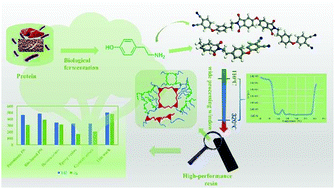A new molecular design platform for high-performance polymers from versatile bio-based tyramine: a case study of tyramine-derived phthalonitrile resin†
Abstract
A molecular design platform based on tyramine, a widely existing bio-amine with flexible structural modifiability, has been employed to synthesis a novel phthalonitrile matrix resin and curing agent in this work. The structures of the products were verified via nuclear magnetic resonance (1H-NMR, 13C-NMR), Fourier-transform infrared spectroscopy (FTIR), and elemental analysis (EA) studies. The rheology and DSC data showed that the tyramine-based resin presented a lower melting point and a wider processing temperature window compared with its petroleum-based counterpart. The cured resin exhibited excellent thermal and thermo-oxidative stability, according to thermal gravimetric analysis (TGA) data, and a high glass-transition temperature (480 °C), based on the dynamic mechanical analysis (DMA) curve. The curing chemistry was studied via ex situ FTIR, in situ FTIR, solid-state nuclear magnetic resonance, and molecular simulation studies. The results showed that the methine moiety of the curing agent may initiate –CN polymerization at lower pre-curing temperatures, and the methylene group of tyramine may act as an active site for secondary crosslinking reactions at higher post-curing temperatures.



 Please wait while we load your content...
Please wait while we load your content...